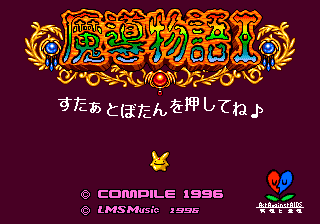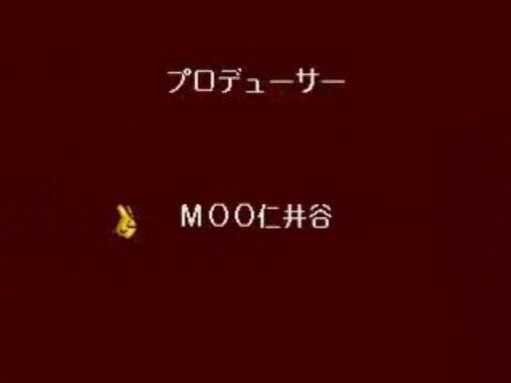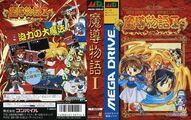Difference between revisions of "Madou Monogatari I"
From Sega Retro
| (One intermediate revision by the same user not shown) | |||
| Line 5: | Line 5: | ||
| developer=[[Compile]] | | developer=[[Compile]] | ||
| support={{company|[[LMS Music]]|role=audio}} | | support={{company|[[LMS Music]]|role=audio}} | ||
| + | | licensor={{company|[[Sega Corporation (2020)|Sega]]|system=ProjectEGG}} | ||
| system=[[Sega Mega Drive]] | | system=[[Sega Mega Drive]] | ||
| sounddriver= | | sounddriver= | ||
| Line 10: | Line 11: | ||
| players=1 | | players=1 | ||
| genre=RPG{{fileref|MMI MD JP Box.jpg}}{{ref|https://web.archive.org/web/20200702232146/https://sega.jp/history/hard/megadrive/software_l.html}} | | genre=RPG{{fileref|MMI MD JP Box.jpg}}{{ref|https://web.archive.org/web/20200702232146/https://sega.jp/history/hard/megadrive/software_l.html}} | ||
| − | | originalsystem=MSX | + | | originalsystem=[[MSX]]2 |
| releases={{releasesMD | | releases={{releasesMD | ||
| md_date_jp=1996-03-22{{ref|https://web.archive.org/web/20200702232146/https://sega.jp/history/hard/megadrive/software_l.html}} | | md_date_jp=1996-03-22{{ref|https://web.archive.org/web/20200702232146/https://sega.jp/history/hard/megadrive/software_l.html}} | ||
| Line 25: | Line 26: | ||
}} | }} | ||
}} | }} | ||
| − | {{stub}}'''''{{PAGENAME}}''''' (魔導物語 I) is a remake of the first part of [[Compile]]'s ''Madou Monogatari 1-2-3'' trilogy of RPGs, and was released for the [[Sega Mega Drive]] in 1996 exclusively in Japan. | + | {{stub}}'''''{{PAGENAME}}''''' (魔導物語 I) is a remake of the first part of [[Compile]]'s ''[[Madou Monogatari 1-2-3]]'' trilogy of RPGs, and was released for the [[Sega Mega Drive]] in 1996 exclusively in Japan. |
It is the last officially released Mega Drive game in Japan (with the last first party game, ''[[Pepenga Pengo]]'', released 3 months earlier), and the only such released in 1996. Out of all the versions of ''Madou Monogatari I'', this is the most different from the others, with a radically different battle system, new characters, and sidequests — however the story and basic gameplay remain (almost) the same. | It is the last officially released Mega Drive game in Japan (with the last first party game, ''[[Pepenga Pengo]]'', released 3 months earlier), and the only such released in 1996. Out of all the versions of ''Madou Monogatari I'', this is the most different from the others, with a radically different battle system, new characters, and sidequests — however the story and basic gameplay remain (almost) the same. | ||
Latest revision as of 13:12, 9 November 2024
- For the Sega Game Gear version, see Madou Monogatari I: 3tsu no Madoukyuu. For the completely unrelated Sega Saturn game in the franchise, see Madou Monogatari.
| Madou Monogatari I | |||||||||||||||
|---|---|---|---|---|---|---|---|---|---|---|---|---|---|---|---|
| System(s): Sega Mega Drive | |||||||||||||||
| Publisher: Compile | |||||||||||||||
| Developer: Compile | |||||||||||||||
| Supporting companies: LMS Music (audio) | |||||||||||||||
| Licensor: Sega | |||||||||||||||
| Original system(s): MSX2 | |||||||||||||||
| Genre: RPG[1][2] | |||||||||||||||
| Number of players: 1 | |||||||||||||||
|
This short article is in need of work. You can help Sega Retro by adding to it.
Madou Monogatari I (魔導物語 I) is a remake of the first part of Compile's Madou Monogatari 1-2-3 trilogy of RPGs, and was released for the Sega Mega Drive in 1996 exclusively in Japan.
It is the last officially released Mega Drive game in Japan (with the last first party game, Pepenga Pengo, released 3 months earlier), and the only such released in 1996. Out of all the versions of Madou Monogatari I, this is the most different from the others, with a radically different battle system, new characters, and sidequests — however the story and basic gameplay remain (almost) the same.
Contents
Story
Arle Nadja is a kindergartener in a magic kindergarten where children learn to become powerful magicians, and she must now complete her final exam by surviving a tower in the kindergarten grounds filled with magic traps that she can overcome by using her magic to gain a better score. Her knowledge and skills will be greatly tested with the puzzles and illusions of fiends that are inside. Not all are illusions though, there may be rivals and friends in this tower, so Arle has to be on the lookout if she wants to pass this test. But she has a dream about encountering a mysterious person in the tower the night before...
Gameplay
Basics
Madou Monogatari I takes place in a first-person 3D perspective, switching to a side view in battles. Diverging from other RPGs (and in tune with the rest of the franchise), Madou Monogatari I will only show one statistic numerically — how much gold the player has to spend. They are expected to judge how healthy and how much power Arle has from her facial expression on screen, dialogue in battle, the music playing in the background, etc. — for example, the music changes if she either becomes too weak, gets poisoned, or loses too much magic power, and her facial expression shows how strong she is.
The Main Screen
The main screen is split horizontally in two, with the top half being where the game area is and the bottom showing either dialogue or jewels collected in battle (See below). The upper half is split into three parts, with Arle's face on the left and the game screen in the middle, and two things on the right: a compass (which you get from new character Camus upon entering the second floor of the tower for the first time) and a number showing how much gold Arle has.
![]() moves forward,
moves forward, ![]() and
and ![]() turn 90° in that direction, and
turn 90° in that direction, and ![]() turns around. Doors can be entered by pressing
turns around. Doors can be entered by pressing ![]() through them. Conversations with NPCs and reading of signs on the tower walls happen automatically when they are encountered, with
through them. Conversations with NPCs and reading of signs on the tower walls happen automatically when they are encountered, with ![]() advancing to the next screen of dialogue. While not doing anything, holding
advancing to the next screen of dialogue. While not doing anything, holding ![]() will allow the player to practice spells (see the battle section below),
will allow the player to practice spells (see the battle section below), ![]() will go through and use items,
will go through and use items, ![]() will show a map, and START will save the game (there are two save slots).
will show a map, and START will save the game (there are two save slots).
Battles
The battle system in Madou Monogatari I is drastically different from the battles of the other versions of 1-2-3. Battles take place in a side view where Arle is on the left and the enemy is on the right. Attacks and moves happen in real time, so the player should think fast and use the time between enemy attacks wisely.
To cast a spell, the player must hold ![]() and hit a sequence of D-pad buttons, then release
and hit a sequence of D-pad buttons, then release ![]() . The sequence determines which spell is done:
. The sequence determines which spell is done:
All spells except Fire and Ice Storm must be learned while navigating the tower.
![]() opens a menu to use an item in battle.
opens a menu to use an item in battle. ![]() tries to run away.
tries to run away. ![]() jumps. START pauses the battle, letting the player see a summary of spells they have learned.
jumps. START pauses the battle, letting the player see a summary of spells they have learned.
Once an enemy is defeated, the player will will get gold and a few jewels on the bottom of the screen. Once the jewel holes on the bottom are all full, Arle will level up, restoring all health and magic in the process.
Items
Money received from battles can be used to purchase items from shops found in room scattered around the tower. The player can hold 9 items in a single item bag and up to three item bags; item bags can be purchased from shops.
Sidequests
Arle's grade on the final exam depends on several sidequests the player completes along the way. Aside from completing certain tasks scattered around the tower and collecting three magic items (akin to the three magic items of the other versions, though not required to complete the game), there are also 40 treasure chests and 40 questions to answer. Opening all 40 treasure chests and solving all 40 questions will both reward lots of points. Some questions request an item be placed into a slot; press ![]() to access items and select the item to place it in the slot.
to access items and select the item to place it in the slot.
Versions
Localised names
| Language | Localised Name | English Translation |
|---|---|---|
| Japanese | 魔導物語 I | Sorcery Saga I |
Production credits
- プロデューサー: MOO仁井谷
- ディレクター: すえなが かつじ
- プランナー: 白龍鳳 霞, ドクターK美
- プログラマー: 秋山 泰俊SS, 野上 真一, TAKIN
- グラフィックデザイナー: けみ, RIU
- サウンド&サンプリング: T.松島, ポリゴンジャンキー
- サウンドドライバー: Jemini
- パッケージ&マニュアル: 阿門, 上人一速 (肉女), 壱
- サンプリングボイス: 井上 麻美
- 協力: 弓 弦之助, 大塚 理恵, 佐野 めぐみ, 藤井 直樹, 石間 光輝, 黒政 健志郎
Digital manuals
Magazine articles
- Main article: Madou Monogatari I/Magazine articles.
Physical scans
| Sega Retro Average | |||||||||||||||||||
|---|---|---|---|---|---|---|---|---|---|---|---|---|---|---|---|---|---|---|---|
|
| 68 | |
|---|---|
| Based on 3 reviews | |
Technical information
- Main article: Madou Monogatari I/Technical information.
References
NEC Retro has more information related to Madou Monogatari 1-2-3
|
NEC Retro has more information related to Madou Monogatari I: Honou no Sotsuenji
|
- ↑ File:MMI MD JP Box.jpg
- ↑ 2.0 2.1 https://sega.jp/history/hard/megadrive/software_l.html (Wayback Machine: 2020-07-02 23:21)
- ↑ https://www.amusement-center.com/project/egg/game/?product_id=1866
- ↑ File:Madou Monogatari I MD credits.pdf
- ↑ 1700 igr dlya Sega, "" (RU; 2001-xx-xx), page 171
- ↑ Famitsu, "1996-03-29" (JP; 1996-03-15), page 34
- ↑ Saturn Fan, "1996 No. 10-11" (JP; 1996-04-26), page 90
| Madou Monogatari I | |
|---|---|
|
Main page | Maps | Magazine articles | Reception | Region coding | Technical information | |
| Madou Monogatari games for Sega systems/licensed by Sega | |
|---|---|
| Madou Monogatari I: 3tsu no Madoukyuu (1993) | Madou Monogatari II: Arle 16-Sai (1994) | Madou Monogatari III: Kyuukyoku Joou-sama (1994) | Madou Monogatari A: Doki Doki Vacation (1995) | |
| Madou Monogatari I (1996) | |
| Madou Monogatari (1998) | |
| Madou Monogatari (2005) | Madou Monogatari I (2008) | Madou Monogatari II (2008) | Madou Monogatari III (2009) | |
| Madou Monogatari Kyu-kyoku Taizen: 1-2-3 & A-R-S (2015) | Madou Monogatari Kyu-kyoku Taizen Tsuu: MD & DS (2016) | Madou Monogatari Kyu-kyoku Taizen Sun: SFC & DS with Lady-Bono! (2017) | Madou Monogatari Kyu-kyoku Taizen Yon: GG I-II-III & A (2018) | Madou Monogatari Chou Kyu-kyoku Taizen: Puyo Puyo Iri (2023) | |
| Carbuncle Pi (2023) | Madou Monogatari 1-2-3 (2023) | Madou Monogatari 1-2-3 PRV: Madou Monogatari Ondo: M. Jackson mo Bikkuri (2024) | Madou Monogatari: Hanamaru Dai Youchienji (2024) | Puyo Puyo Koi Monogatari (2024) | Wonderland of Carbuncle (2024) | |





